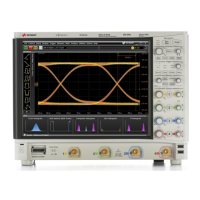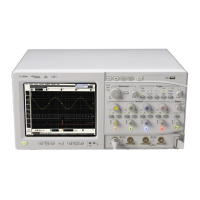40 S-Series Oscilloscopes Service Guide
3 Testing Performance
21 Move the splitter to channel 2 and change the oscilloscope configuration as
follows:
a Click Control > Factory Default.
b Ensure channel 2 is displayed and all other channels are turned off.
c Set the vertical scale of channel 2 to 5 mV/div.
d Set the horizontal scale to 16 ns/div (to display 8 cycles of a 50 MHz
waveform).
e Click Trigger> Setup Trigger... and change the source to channel 2.
f Click Measure > Add Measurement.... Select the Vertical RMS voltage
measurement, Channel 2 as the source, Entire Display as the Measurement
Area, and AC for the RMS Type.
22 Repeat steps 6d and 7 to 20 to complete measuring gains for channel 2.
23 Move the splitter to channel 3 and change the scope configuration as follows:
a Click Control > Factory Default.
b Ensure channel 3 is displayed and all other channels are turned off.
c Set the vertical scale of channel 3 to 5 mV/div.
d Set the horizontal scale to 16 ns/div (to display 8 cycles of a 50 MHz
waveform).
e Click Trigger> Setup Trigger... and change the source to channel 3.
f Click Measure > Add Measurement.... Select the RMS voltage measurement,
Channel 3 as the source, Entire Display as the Measurement Area, and AC
for the RMS Type.
24 Repeat steps 7 to 20 to complete measuring gains for channel 3.
25 Move the splitter to channel 4 and change the scope configuration as follows.
a Click Control > Factory Default.
b Ensure channel 4 is displayed and all other channels are turned off.
c Set the vertical scale of channel 4 to 5 mV/div.
d Set the horizontal scale to 16 ns/div (to display 8 cycles of a 50 MHz
waveform).
e Click Trigger> Setup Trigger... and change the source to channel 4.
f Click Measure > Add Measurement.... Select the RMS voltage measurement,
Channel 4 as the source, Entire Display as the Measurement Area, and AC
for the RMS Type.
26 Repeat steps 7 to 20 to complete measuring gains for channel 4.

